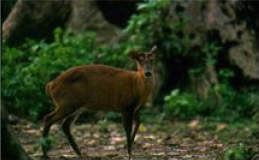Loss of wildlife is threatening biodiverse forests in northeastern India
Loss of wildlife is threatening biodiverse forests in northeastern India
mongabay.com
September 15, 2008
|
|
Logging, agricultural expansion, and hunting of large birds and mammals in the tropical forests of northeastern India may be reducing the capacity of the biologically-rich ecosystem to regenerate itself, report researchers writing in the open-access journal Tropical Conservation Science.
Analyzing the dispersal modes and spatial patterns of 128 tree species in the tropical semi-evergreen forest of Arunachal Pradesh in the eastern Himalayas, Aparajita Datta and G.S. Rawat found that 78 percent of trees are dispersed by animals and that tree species distributions are to an extent limited by dispersal. The results suggest that declines of hornbills, ungulates, bears, and primates — major dispersers for many tree species — as a result of human activity, are “likely to have consequences for the dispersal and recruitment of many tree species in these forests, especially several rare large-seeded tree species.”
 Indian muntjac or barking deer Muntiacus muntjac. Photo by SU Saravana Kumar. |
Population growth in the global biodiversity hotspot is a particular challenge, note the researchers. While the region has the lowest population density in India, a population growth rate of three percent per year has put pressure on community-owned forest reserves for food, timber, and non-timber forest products. However it is this dependence — combined with improved relations between the Forest department and the Nishi, a local tribe — that may help facilitate more effective conservation action in Pakke Wildlife Sanctuary and the surrounding area, say Datta and Rawat.
“The Nishi are mainly dependent on subsistence agriculture; there are few employment opportunities and there are conflicts with the Forest Department over crop-raiding by elephants.,” the authors write. “The local community has mostly viewed the Forest Department and the presence of a sanctuary with resentment.”
“From 2002 onwards, the Forest Department and national conservation organizations have attempted to address the problem faced by local communities, and this has generated greater support for the park. Hunting of wildlife such as hornbills, primates and ungulates in the park appears to have declined since 2002 due to better protection by park authorities and greater awareness and enforcement of hunting bans by the Nishi community.”
Datta and Rawat conclude by arguing that efforts to protect forest resources and biodiversity will be in the best interest of local communities.
“Our results stress the ecological and social value of preserving ecological processes that are sustained by plant-animal interactions,” they write. “The study has also generated information on the natural history and ecology of several important vertebrate species and improved our understanding of the forests in the area. This knowledge can be used to enhance conservation awareness among local communities in the area.”
Aparajita Datta and G.S. Rawat. Dispersal modes and spatial patterns of tree species in a tropical forest in Arunachal Pradesh, northeast India. Tropical Conservation Science Vol. 1(3):163-185, September 2008